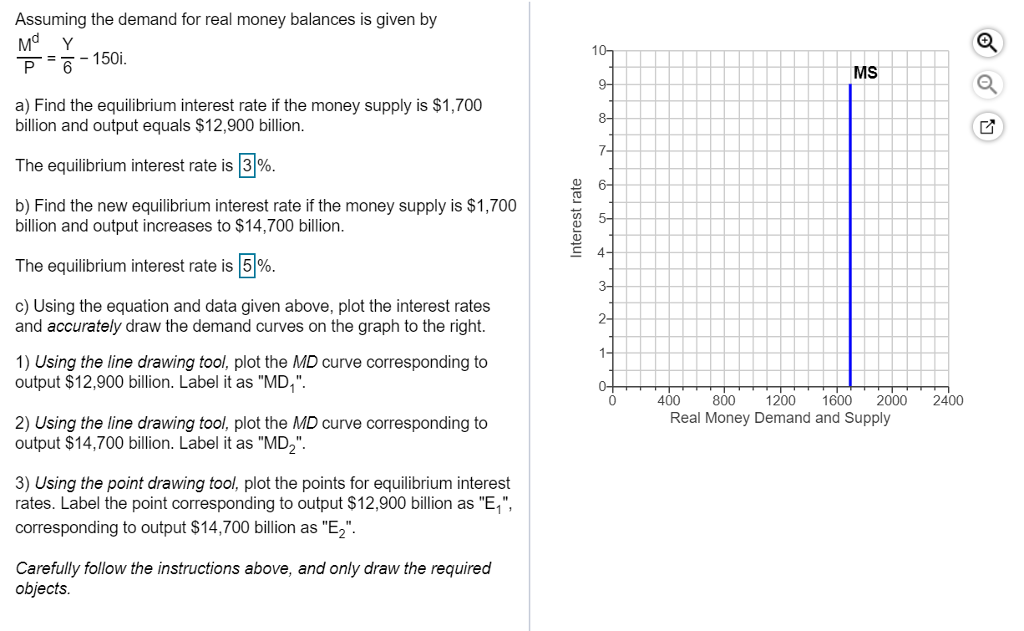- Balance Equations Worksheet
- Real Money Balances Equations Calculator
- Money Equations Inc
- Balance An Equation Calculator
- Real Money Balances Equation
Keynes Equation: Keynes gives his real-balance quantity equation as an improvement over the other Cambridge equations. According to him, the demand for money is with reference only to consumer goods. In other words, people hold money to buy or to represent only goods and services. Keynes’ equation is as follows.
- Velocity) is stable (or at least predictable) I Doesn’t seem to be the case, particularly in last several decades I Liquidity preference theory of money demand posits that the demand for real money balances, m t = M t P t, is an increasing function of output, Y t, but a decreasing function of the nominal interest rate, i t: M.
- If the price level rises from 2 to 4, then real money balances fall from 500 to 1;000=4 = 250.The LM equation becomes: Y= 250 + 100r. As shown in Figure 12-15, the LM curve shifts tothe left by 250 because the increase in the price level reduces real money balances.
Dissatisfied with Pigou’s equation, Keynes formulated his own equation called “The Real Balance Quantity Equation” which is as under:
P = n/k
Where, n is the quantity of money in circulation,
ADVERTISEMENTS:
p is the price of a consumption unit,
k refers to the real balance. It is measured as the amount of consumption units (viewed as a set of specified quantities of the people’s standard items of consumption) the community prefers to hold in the form of cash.
It is easy to see that if k is constant, a change in causes a proportional change in p.
Balance Equations Worksheet
To consider the bank deposits component of money supply, Keynes extended the equation as follows:
P = n/k + rk’
Where, r denotes cash reserve ratio, i.e., the proportion of cash reserves maintained by banks against their deposits.

k stands for the real balance held in the form of bank money.
Thus, if k, k’ and r remain unchanged, n and p will directly vary in the same proportion.
ADVERTISEMENTS:
Keynes, however, does not regard that k and k’ are independent of n – the stock of money. Again, k and k’ may not be affected by small changes in the stock of money.
But they are bound to be affected by large changes in the stock of money. When k, k’ and r are influenced by n, there is no fully proportionate variation of p caused by changes in n.
In reality, p will change as per the changes in the ratio n/k’
Thus, Keynes’ approach is more rational than that of Pigou.
Keynes’ real balance equation, however, is not free from defects. In fact, Keynes himself had recognised certain defects in it, which he pointed out later, in his Treatise on Money, as discussed below:
Real Money Balances Equations Calculator
1. In Keynes’ equation, P refers only to the price level of consumption standard value of money, in a narrow sense. In other words, P does not measure the purchasing power of money in a general sense.
2. The real balance equation disregards industrial and financial transactions; hence its application is limited.
3. When P measures only the price level of consumption units, the equation seems to suggest that people hold money only to secure consumption goods. But in reality, people hold money for a “vast multiplicity of business and personal purposes” and with a multiplicity of motives, such as transactionary, precautionary and speculative.
ADVERTISEMENTS:
4. There is no justification for deducing a proportional relationship between n and p in the short period from the equation, when k, k’ and r might, and do, change as a result of changes in.
Money Equations Inc
Recognising that a change in n will affect k, k’ and r, Keynes himself admits, as we have noted above, that in a short period, there is no proportionate relationship between n, the quantity of money, and P, the price level, though in the long run, he feels such a relationship would be normal.
But, on the other hand, in his Tract on Monetary Reform, Keynes assumed constant levels of output and employment and followed the conclusion that when n is changed, volume of output remaining constant, the net effect would be a proportionate change in the price level. But, in fact, in the short period, the levels of output and employment are subject to changes.
However, the shortcomings of the Tract equation have been overcome by Keynes in his General Theory.
He had integrated the theory of money with the theory of output, and ascertained that the quantity theory of money subsists only in a state of full employment. In a state of under-employment, changes in prices are caused by changes in the level of income rather than in the money supply.
Keynes thereby abandoned the cash balances approach, and adopted the income-expenditure approach to the value of money.
Related posts:
The Equation of Exchange addresses the relationship between money and price level, and between money and nominal GDP.
The equation simply states: M x V = P x Y
Where M = the money supply, usually the M1
V = the velocity of money
P = the price level
Y = real output, or real GDP.
Velocity is the number of times the average dollar is spent to buy final goods and services in a given year. Velocity can be calculated by using V = (P x Y ) / M

Balance An Equation Calculator
The equation tells us that total spending (M x V) is equal to total sales revenue (P x Y). Since (P x Y) is equal to the nominal GDP, then M x V = nominal GDP.
Velocity (V) and Real GDP (Y) are effectively constant in the short run, therefore any changes in money supply (M), will cause a proportional change in the price level (P).
Re-writing the equation, we get: P = ( M x V ) / Y
Real Money Balances Equation
This equation demonstrated a direct relationship between price and money supply. If V and Y are constant, a certain percentage change in money supply will cause a same amount of change in the price level.